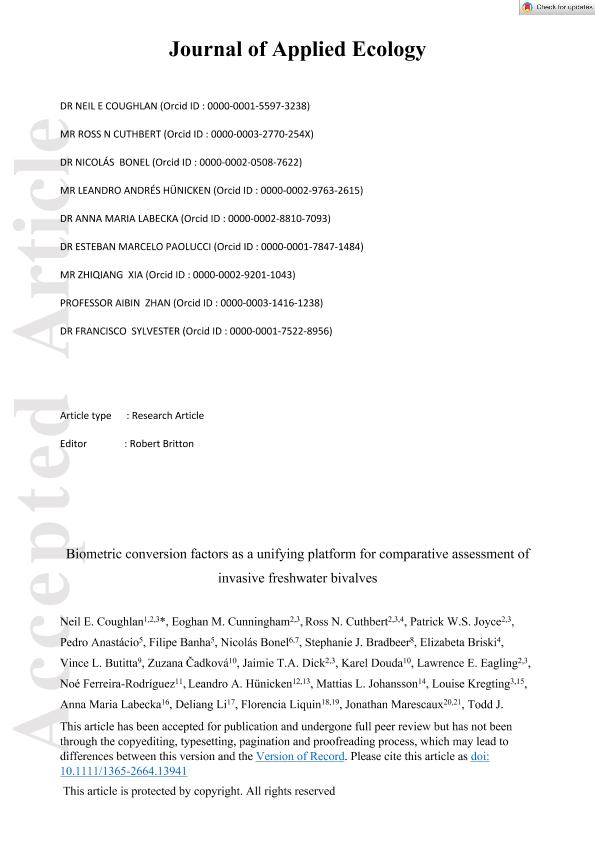Artículo
Biometric conversion factors as a unifying platform for comparative assessment of invasive freshwater bivalves
Coughlan, Neil E.; Cunningham, Eoghan M.; Cuthbert, Ross N.; Joyce, Patrick W. S.; Anastácio, Pedro; Banha, Filipe; Bonel, Nicolás ; Bradbeer, Stephanie J.; Briski, Elizabeta; Butitta, Vince L.; Cadková, Zuzana; Dick, Jaimie T. A.; Douda, Karel; Eagling, Lawrence E.; Ferreira Rodríguez, Noé; Hünicken, Leandro Andrés
; Bradbeer, Stephanie J.; Briski, Elizabeta; Butitta, Vince L.; Cadková, Zuzana; Dick, Jaimie T. A.; Douda, Karel; Eagling, Lawrence E.; Ferreira Rodríguez, Noé; Hünicken, Leandro Andrés ; Johansson, Mattias L.; Kregting, Louise; Labecka, Anna Maria; Li, Deliang; Liquin, Florencia Fernanda
; Johansson, Mattias L.; Kregting, Louise; Labecka, Anna Maria; Li, Deliang; Liquin, Florencia Fernanda ; Marescaux, Jonathan; Morris, Todd J.; Nowakowska, Patrycja; Ozgo, Malgorzata; Paolucci, Esteban Marcelo
; Marescaux, Jonathan; Morris, Todd J.; Nowakowska, Patrycja; Ozgo, Malgorzata; Paolucci, Esteban Marcelo ; Peribáñez, Miguel A.; Riccardi, Nicoletta; Smith, Emily R. C.; Sylvester, Francisco
; Peribáñez, Miguel A.; Riccardi, Nicoletta; Smith, Emily R. C.; Sylvester, Francisco
 ; Bradbeer, Stephanie J.; Briski, Elizabeta; Butitta, Vince L.; Cadková, Zuzana; Dick, Jaimie T. A.; Douda, Karel; Eagling, Lawrence E.; Ferreira Rodríguez, Noé; Hünicken, Leandro Andrés
; Bradbeer, Stephanie J.; Briski, Elizabeta; Butitta, Vince L.; Cadková, Zuzana; Dick, Jaimie T. A.; Douda, Karel; Eagling, Lawrence E.; Ferreira Rodríguez, Noé; Hünicken, Leandro Andrés ; Johansson, Mattias L.; Kregting, Louise; Labecka, Anna Maria; Li, Deliang; Liquin, Florencia Fernanda
; Johansson, Mattias L.; Kregting, Louise; Labecka, Anna Maria; Li, Deliang; Liquin, Florencia Fernanda ; Marescaux, Jonathan; Morris, Todd J.; Nowakowska, Patrycja; Ozgo, Malgorzata; Paolucci, Esteban Marcelo
; Marescaux, Jonathan; Morris, Todd J.; Nowakowska, Patrycja; Ozgo, Malgorzata; Paolucci, Esteban Marcelo ; Peribáñez, Miguel A.; Riccardi, Nicoletta; Smith, Emily R. C.; Sylvester, Francisco
; Peribáñez, Miguel A.; Riccardi, Nicoletta; Smith, Emily R. C.; Sylvester, Francisco
Fecha de publicación:
09/2021
Editorial:
Wiley Blackwell Publishing, Inc
Revista:
Journal of Applied Ecology
ISSN:
0021-8901
e-ISSN:
1365-2664
Idioma:
Inglés
Tipo de recurso:
Artículo publicado
Clasificación temática:
Resumen
Invasive bivalves continue to spread and negatively impact freshwater ecosystems worldwide. As different metrics for body size and biomass are frequently used within the literature to standardise bivalve-related ecological impacts (e.g. respiration and filtration rates), the lack of broadly applicable conversion equations currently hinders reliable comparison across bivalve populations. To facilitate improved comparative assessment among studies originating from disparate geographical locations, we report body size and biomass conversion equations for six invasive freshwater bivalves (or species complex members) worldwide: Corbicula fluminea, C. largillierti, Dreissena bugensis, D. polymorpha, Limnoperna fortunei and Sinanodonta woodiana, and tested the reliability (i.e. precision and accuracy) of these equations. Body size (length, width and height) and biomass metrics of living-weight (LW), wet-weight (WW), dry-weight (DW), dry shell-weight (SW), shell free dry-weight (SFDW) and ash-free dry-weight (AFDW) were collected from a total of 44 bivalve populations located in Asia, the Americas and Europe. Relationships between body size and individual biomass metrics, as well as proportional weight-to-weight conversion factors, were determined. For most species, although inherent variation existed between sampled populations, body size directional measurements were found to be good predictors of all biomass metrics (e.g. length to LW, WW, SW or DW: R2 = 0.82–0.96), with moderate to high accuracy for mean absolute error (MAE): ±9.14%–24.19%. Similarly, narrow 95% confidence limits and low MAE were observed for most proportional biomass relationships, indicating high reliability for the calculated conversion factors (e.g. LW to AFDW; CI range: 0.7–2.0, MAE: ±0.7%–2.0%). Synthesis and applications. Our derived biomass prediction equations can be used to rapidly estimate the biologically active biomass of the assessed species, based on simpler biomass or body size measurements for a wide range of situations globally. This allows for the calculation of approximate average indicators that, when combined with density data, can be used to estimate biomass per geographical unit-area and contribute to quantification of population-level effects. These general equations will support meta-analyses, and allow for comparative assessment of historic and contemporary data. Overall, these equations will enable conservation managers to better understand and predict ecological impacts of these bivalves.
Archivos asociados
Licencia
Identificadores
Colecciones
Articulos(CCT - SALTA-JUJUY)
Articulos de CTRO.CIENTIFICO TECNOL.CONICET - SALTA-JUJUY
Articulos de CTRO.CIENTIFICO TECNOL.CONICET - SALTA-JUJUY
Articulos(CERZOS)
Articulos de CENTRO REC.NAT.RENOVABLES DE ZONA SEMIARIDA(I)
Articulos de CENTRO REC.NAT.RENOVABLES DE ZONA SEMIARIDA(I)
Articulos(MACNBR)
Articulos de MUSEO ARG.DE CS.NAT "BERNARDINO RIVADAVIA"
Articulos de MUSEO ARG.DE CS.NAT "BERNARDINO RIVADAVIA"
Citación
Coughlan, Neil E.; Cunningham, Eoghan M.; Cuthbert, Ross N.; Joyce, Patrick W. S.; Anastácio, Pedro; et al.; Biometric conversion factors as a unifying platform for comparative assessment of invasive freshwater bivalves; Wiley Blackwell Publishing, Inc; Journal of Applied Ecology; 58; 9; 9-2021; 1945-1956
Compartir
Altmétricas



